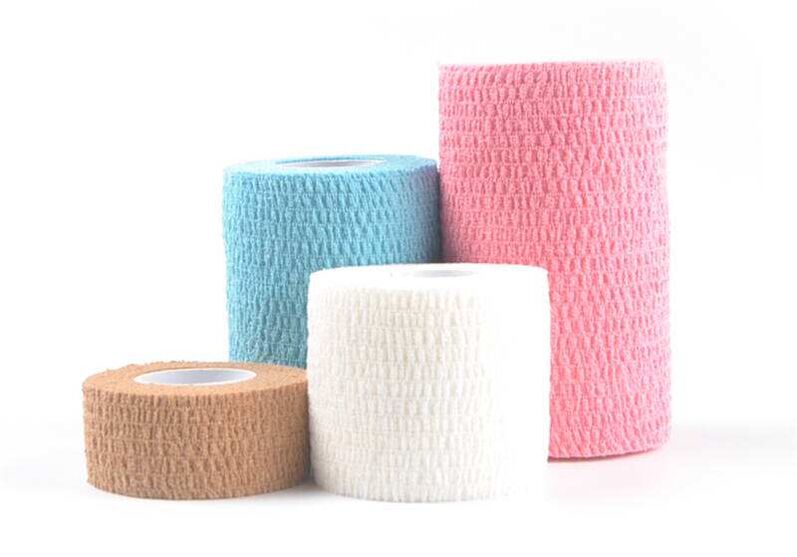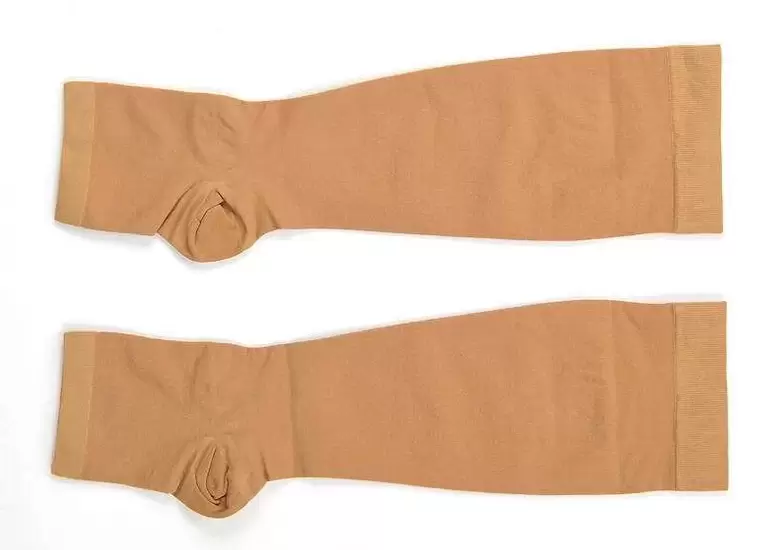Compression garments for varicose veins normalize blood flow, partially compensate for valvular insufficiency, and relieve pain and fatigue. It is used both before and after the treatment of varicose veins for easier recovery. They are effective in conservative and minimally invasive treatment, eliminate the need for bandages and allow you to get a real result that corresponds to the intended one.
In 2018, a large study was conducted on the effect of compression stockings in the conservative treatment of varicose veins. It turned out that when using the first class of compression, the course of the disease slows down significantly, pain and swelling disappear. The positive effect of compression after surgical and minimally invasive treatment has been repeatedly proven; large studies have been conducted since 1985.
Currently, three types of compression underwear are produced - tights, socks of different heights and knee socks. The compression class is prescribed by a phlebologist during a face-to-face consultation.
Elastic compression of the lower extremities is by no means new in medicine. As far back as ancient Egypt, slaves and laborers practiced foot binding to increase endurance and performance, and Roman legionnaires bound their feet during long walks. A similar method was used later, in the 17th and 19th centuries. century, it was used by workers in factories and plantations to speed up the recovery process and reduce swelling in the limbs after a hard day.

The method of dosed external compression has also been used in medicine. The feasibility of its use in venous pathology was identified as early as the time of Hippocrates. Even then, the disease was described with the presence of bulging superficial veins on the leg, swelling of the affected limb and a tendency to ulceration. And pressure bandages and spiral bandages were widely used for its treatment.
This technique has not been forgotten. New methods of limb dressing for varicose veins and chronic venous insufficiency were gradually developed. Elastic compression was also used as an independent method. The most commonly used materials were cotton and knitwear and rubber bands.
The breakthrough was the emergence of an elastic bandage. It was patented in 1845 by British entrepreneur and inventor Stephen Perry and subsequently improved. After that, bandages of 3 degrees of stretch on the basis of different materials began to be produced. They are still in use today. But the elastic bandage has a number of significant disadvantages.
Disadvantages of an elastic bandage:
- inconvenience;
- dependence of the results on careful adherence to the application technique;
- probability of uneven distribution of compression;
- unaesthetic;
- the risk of shifting material bends.
In 1848, another product was patented, which gave impetus to the emergence of a new direction in compression therapy. William Brown invented stockings that allowed circular pressure to be distributed to the lower limbs. Over time, the progress of light industry enabled the production of tights. And currently, compression stockings are recommended for use in various diseases that affect the veins of the lower extremities.
Classification of compression stockings
Modern compression products are available in the form of leggings, socks of various heights and knee socks. But they are not only divided by appearance. They are also divided into classes according to the degree of compression they provide. It is measured in millimeters of mercury.

The classification of used compression products is based on the German standard RAL-GZ 387 adopted in Europe. It is the strictest and regulates the nature of pressure distribution and its compliance with physiological patterns of venous outflow, quality and composition of materials. used.
Compression garments are divided into 4 classes:
Easy. Compression 18–21 mm Hg.Average (moderate). Compression 23–32 mm Hg.Strong. Compression 34–46 mm Hg.Very strong. Compression 49 mm Hg.
The term "tightness" is sometimes used to describe compression tights and stockings. In fact, it is a false substitute for the concept of "compression". This pseudo-medical formulation is based on the fact that with an increase in the level of pressure, underwear actually becomes less stretchy and denser to the touch. compression and density of regular tights (measured in DEN) is illiterate and fundamentally wrong.
What is the difference between compression underwear and normal compression stockings?
Compression socks do more than just compress the soft tissue of the legs. The pressure it exerts is carefully calculated and strictly dosed, which is ensured by the use of special materials with special thread weaving and composition. According to the RAL-GZ 387 standard, tights and socks cannot be transparent, transparent, colored or colorful.
An important feature of compression stockings is the pressure gradient - its gradual decrease as it rises from the level of the ankle joint to the thigh. Moreover, these changes correspond to the physiological characteristics of the peripheral veins and the nature of the blood flow.
The greatest pressure is in the supramalleolar region. Compression begins in the upper third of the foot, affecting the ankle joint - this is where the large saphenous vein originates on the medial side and its main tributaries are located. Approximately at the level of the transition of the abdominal muscle of the calf to the Achilles tendon, the pressure exerted by the socks (socks) is already about 65-70% of the supramalleolar pressure. About 50% is in the knee. And in the lower third of the thigh - 40% of the original.
The gradient has a dosed effect on the peripheral superficial veins of the lower limb and creates blood flow close to physiological.
What changes when you wear a compression suit for varicose veins?
Compression tights exert a dosed circular pressure, the level of which is determined by the compression class. The most affected are bulging varicose veins, which arise in accordance with Laplace's law. All other superficial vessels are also compressed.
On a mechanical level:
- Reducing the diameter of venous vessels allows you to reduce the volume of deposited and stagnant blood.
- Pressure on varicose veins helps to reduce the effect of valvular insufficiency and reduce backflow of blood.
- Reducing the volume of horizontal reflux through the perforating vessels, increasing blood flow into the deep veins of the legs.
- Improving the work of the lower leg muscle pump.
In general, compression tights and stockings have a symptomatic effect and reduce the severity of chronic venous insufficiency. Underwear creates comfort for severe varicose veins. However, we cannot talk about a cure: the patient only improves the quality of life and reduces the likelihood of complications.
Compression garments do not remove varicose veins, do not restore the structure of peripheral vessel walls and cannot replace surgery. It only allows for the correction of existing signs of venous insufficiency, and this effect only lasts while wearing tights/socks.
The result of wearing compression knit underwear:
- reduction of lower leg and ankle swelling, including in the evening and after periods of prolonged standing;
- decrease in the intensity of pain, which is explained by a decrease in the degree of venous blood stagnation and improved tissue trophism;
- reducing the risk of thrombosis;
- reducing the severity of trophic disorders and reducing the probability of their occurrence;
- reduction of the duration of the rehabilitation period after surgical interventions and minimally invasive manipulations on veins;
- reduction of the feeling of discomfort in the legs;
- reducing the frequency and strength of leg muscle cramps.
Wearing a compression garment is recommended for varicose veins of any stage, postphlebotrombotic syndrome (PFTS). In some cases, it is also recommended for reticular varicose veins and telangiectasias (spider veins), lymphostasis of the lower extremities.
Special importance is attached to compression therapy after operations and minimally invasive endovascular procedures (EVLO, laser obliteration, RFO). Wearing specialized knitwear significantly increases the effectiveness of such interventions.
Indications and contraindications
Indications:
- After sclerotherapy, for better contact and subsequent fibrous "gluing" of the walls of the sclerosed vessel.
- Pronounced tissue changes due to chronic venous insufficiency (in the presence of trophic ulcers, lipodermatosclerosis).
- Phlebitis of superficial veins.
- Swelling, pain, tiredness in the legs.
- Tendency to be overweight.
Contraindications:
- clinically significant obliterating atherosclerosis of the lower extremities;
- endarteritis;
- pustular diseases of the skin of the lower extremities and microbial eczema;
- bedsores;
- open wounds;
- diabetes mellitus with signs of endocrine polyneuropathy and disturbed microcirculation in the distal extremities;
- acute cardiovascular failure.
The possibility of wearing compression stockings is determined by your doctor. A change in the patient's condition and the appearance of new symptoms require a second consultation with a phlebologist to determine further treatment tactics.
How to choose a compression product?
Compression clothing cannot be chosen independently, they are prescribed exclusively by a phlebologist based on an examination and ultrasound examination of the veins of the lower extremities.
The right choice
When choosing compression, consider the following:
- nature and speed of venous blood flow;
- severity of pathological vertical and horizontal reflux;
- the presence of blood outflow obstruction, which is most often caused by thrombosis.
Many patients have a completely logical question: why go to the doctor if the package of underwear contains a description of compression classes and indications for them? Is it not possible to pass with the help of a consultant in an orthopedic salon?
No, self-analysis of symptoms is not enough for the correct selection of compression garments: the doctor focuses not only on the degree of venous insufficiency and clinical symptoms. Other factors are also important. And the decisive parameters often become age and the presence of accompanying somatic pathology: sometimes the use of a high class of compression is fraught with worsening of the general condition, despite the correction of venous insufficiency.
Pay attention to the level of compression and the way you wear it
Risks of wearing compression class 3 in old age:
- Risk of stroke, heart attack.
- Severe cardiovascular insufficiency.
Determining the tactics of treatment and choosing the class and type of compression stockings is the prerogative of the doctor. But the consultant of the orthopedic salon can handle the selection of the size and height of the product. He will also provide detailed care instructions and teach you how to properly wear compression tights and socks.
Preference should be given to brands whose manufacturers are guided by the RAL-GZ 387 standard. This will be indicated by the corresponding icon on the packaging. The standard is a guarantee of high quality, physiology and predictability.
High-quality therapeutic anti-varicose jersey is not sold in pharmacies. The products are presented in orthopedic salons.
Do not save money - do not buy fakes and products from unknown manufacturers. The compression will almost certainly differ from the declared one, and the durability of the product will be low.
How to wear and how much to wear
The sock is first turned and folded into a roll, and then rolled out along the leg from bottom to top. This will ensure proper pressure distribution and prevent product deformation. There are also special devices that make it easier to put on. They can also be bought in orthopedic stores.
It is advisable to wear compression stockings in the morning while you are still in bed: at that time the swelling of the legs is usually minimal, so that optimal compression of the veins can be achieved. It is also recommended to keep your legs elevated for a few minutes before putting on socks and "work out" your feet to further increase the outflow of venous blood and lymph.
Compression products against varicose veins are sometimes worn for a long time, removed only in the evening before going to bed. Such recommendations can be given, for example, for postphlebotrombotic syndrome (PFTS), thrombophlebitis and persistent edematous syndrome. In other cases (with initial varicose veins), it is enough to wear such socks (socks) only in periods of static or dynamic loads. The rules for wearing a compression suit are determined by your doctor.












































